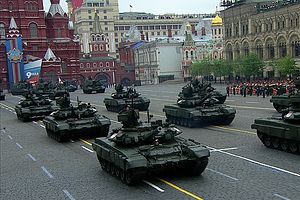Russian defense contractors are making record profits despite the ongoing conflict in Ukraine and the pressure of Western sanctions, Defense News reports.
“Russian defense firms featured in this year’s Defense News Top 100 ranking saw surging revenues as exports reached new highs and the government poured money into defense procurement,” the article notes.
One company, the Tactical Missile Corporation JSC, saw a 48.6 percent rise in its annual revenue to $2.8 billion. The country’s largest producer of air defense systems, Almaz-Antey, increased its revenue by ten percent to $9.2 billion, up $882.5 million in comparison to 2013.
Other Russian firms that fared well: “the United Aircraft Corp., which owns Sukhoi, MiG and Irkut, and saw revenues rise 7 percent to $6.2 billion; Russian Helicopters, which finished at $3.96 billion, up 16 percent over 2013; and the United Engine-building Company, which saw a 25 percent increase over 2013 revenues to $3.3 billion in 2014,” according to Defense News.
Interestingly, the world’s largest main battle tank manufacturer, UralVagonZavod (UVZ), reported only a one percent revenue increase in 2014. However, this is likely to change soon, since UVZ will begin mass-producing the T-14 Armata main battle tank in 2017 with the goal of producing a total of 2,300 T-14 models by 2020 at a cost of $8 million per unit (See: “Is the World’s Deadliest Tank Bankrupting Russia?”).
There was no data available on Russia’s military shipbuilding industry.
One explanation for the boom in Russia’s defense industry is strong exports–$13.2 billion worth of military hardware was sold abroad in 2014. Russia’s arms export markets are primarily non-Western (Algeria, China, India, and Venezuela etc.) and consequently the Western-imposed economic sanctions did not affect business.
The second explanation is domestic spending. Back in 2010, President Vladimir Putin launched a massive 20 trillion ruble (roughly $330 billion) military modernization project that aims to replace 70 percent of Soviet-era military hardware by 2020, including 50 new warships for the navy, hundreds of new fighter jets, and thousands of new vehicles for the ground forces.
However, with the ruble declining in value, rising inflation and a drop in the global price of oil, it will become increasingly more expensive for the Russian government to procure new weapons. A I noted in a previous article on Russia’s defense budget:
The verdict is simple: Russia cannot afford military expenditures at such scale in the long-run. “The modern Russian economy just does not generate enough resources to finance the current 2011-2020 rearmament program. This seriously reduces the ability to efficiently renew the Russian armed forces’ equipment,” a recent analysis by the Moscow-based defense think tank CAST notes.
The only way for Russia to currently finance its growing military expenditure is to tap into the country’s reserve fund – money the Kremlin put aside over the last few years when oil prices were high and meant to cushion the economy against shocks. With the help of the reserve fund – worth approximately six percent of the country’s total GDP – Russia could maintain a 3.7% deficit for less than two years, according to the economist Sergei Guriev.
Yet, this calculation may perhaps be too optimistic, the Russian-born scholar admits, given the Kremlin’s exorbitant spending on defense: “Russia has already spent more than half of its total military budget for 2015. At this rate, its reserve fund will be emptied before the end of the year.”
In addition, Western-imposed sanctions will disrupt supply chains of Russian defense contractors, since not all components of weapon systems can be indigenously produced (See: ”Is Russia’s Deadliest Tank Using Western Technology?”).
This is most acutely felt in Russia’s shipbuilding industry. As I reported before (See: “How the Ukraine Crisis Interrupts Putin’s Naval Dreams”), the Russian surface fleet is particularly affected by the sanctions since some of its newest surface ship classes—the Admiral Grigorovich-class (Project 11356) and Admiral Gorshkov-class (Project 22350) guided missile frigates—require Ukraine-made gas turbine engines.
Vladimir Putin, however, will in all likelihood press on with his modernization program, as I explained in another article.































